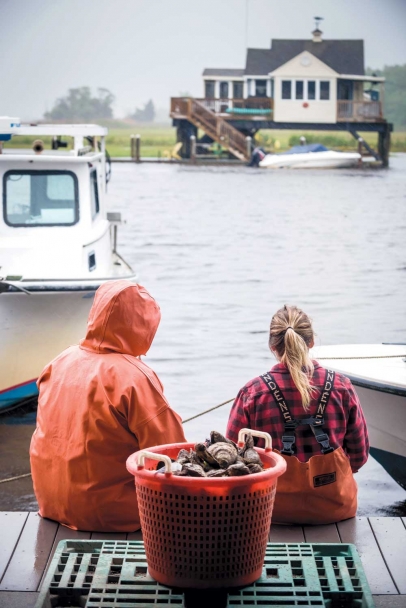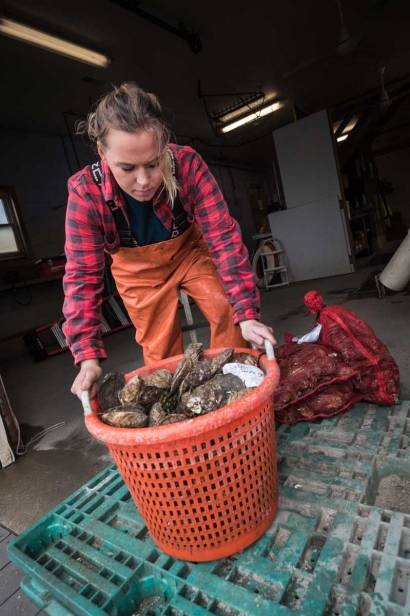OLD STOCK, NEW GENERATION
The Maxwell legacy, wild oysters and Bridgitte
Well before the average 26-year-old has even thought about hitting snooze, Bridgitte Maxwell is up and heading out onto the bay with her Dad, John, and her “Poppop,” Donald, on the Captain Curtis Maxwell, a dredge named for her paternal great-grandfather. You want to see the definition of hustle? Spend time with a rising oysterwoman. This is good, old-fashioned work.
Read between the lines of his wry, salty demeanor—one honed over years on the water, and delivered via a constant stream of quips—and John’s pride in his daughter shines clear. Was he surprised that Bridgitte pushed to join the family business, the first woman in the family to do so? Sure. Is he happy to have her there? You bet.
“I don’t know what I’d do without her, to be honest,” he says. “I’ve done this since I was a little kid, since like 1963. There are probably laws against that now. That there’s someone here to carry it on is very gratifying for me.”
You get the sense that her determination matches his own. Like dad, Bridgitte grew up on the docks, hauling clams and lending a hand. Now, she’s surprising herself with what she can do, from dumping dredges to pushing thousands of pounds of shell. (Maxwell’s oysters are “planted” on open bottom and then wild caught en masse, an exception on the Atlantic Coast’s smaller bays made possible by the family’s extensive leases.) “My very first day of being on the boat, we did shelling,” she recalls. “You pile all of the shells on, take them out into the river, and push them over, so then they’ll spawn. We filled that old wooden boat with a tractor about seven times.”
Though she was mighty sore, with purple palms, she says you’d be surprised at what you can do if you’re willing to work hard. Clearly, that runs in the family. The Maxwell Shellfish brand name goes back to the ’30s in Port Republic, where the Mullica River and Great Bay meet. But the family’s roots on the water go deeper. “Our family has been here since the Revolution, and they’ve all been baymen,” Bridgitte says. Given that history, it’s unsurprising that she describes their oysters, known as Graveling Points and Crab Islands, as tasting how the bay smells, and how it feels. To her, they taste like home. “We have a long line of water blood, that’s what my dad says.”
Bridgitte isn’t the first woman in Jersey with water blood. In The Bayman, Merce Ridgway’s ode in prose to a life on the Barnegat Bay, he describes a shock that came early in his career. Heading out one morning to the Cedar Run flats, he encountered none other than his aunts and grandmother tonging clams—a lo-fi form of harvesting where shellfish are gathered using conjoined rakes. “Although I should have known, I didn’t realize that some of the women in the family would be out there working,” he writes.
“Giving fair credit to them, they sometimes caught as many or more than the men did.”
In a modern context, one thinks of Betsy Haskin, who owns Betsy’s Cape Shore Salts. She’s the daughter of Harold H. Haskin, the Rutgers marine biologist credited with saving the industry with his pioneering MSX-resistant seed. Then there’s Rutgers researcher Lisa Calvo, who grows Sweet Amalia oysters in the Lower Delaware Bay.
For Bridgitte, though, breaking boundaries wasn’t the draw. It’s more like a mission. She’s heir to a wild, disease-resistant oyster stock in the Mullica that has scientists across the state intrigued. Though it doesn’t come from the Rutgers hatchery, it has managed to make it through successive waves of disease, Dermo included. In effect, the Maxwell family bred their own disease-resistant stock, tending their oysters even when the market was dead and they had switched to clams.
In his typical joking style, John downplays the family’s role in that process, and would have you believe their success was dumb luck. “It’s like we’re getting ready to fight the Civil War here. That’s the level of innovation we have,” he says. “Like my Dad says, it doesn’t pay to be too smart.”
In fact, the cultivation of that stock required foresight and hard work without a guaranteed payoff. The way Steve Evert, manager of Stockton’s Marine Field Station sees it, the Mullica’s productivity as the Atlantic’s only commercially viable wild oyster ground owes much to the Maxwell family. “If nobody over the last 30 or 40 years had been actively shelling and harvesting and providing substrate for wild set, I don’t know how many oysters would be in the Mullica,” he says. “Their active management of their own leases for their business purposes has had great ecological benefits.”
Now, there are signs of health on the Great Bay, from the occasional bay scallop to fish that John hasn’t seen in years. For Bridgitte, that’s a heritage to carry forward. “We have natural seed that’s been in our family for generations—the lots and the land,” Bridgitte reflects. “It’s a natural line that we don’t do anything to, and it does really well here.”
It’s an apt metaphor for a business that unites three generations daily, Donald still helming the dredge at 89. “I was coming up the creek the other day, and they were sitting there, all three of them, culling through their oysters,” Evert says. “Bridgitte, John and Donald, all sitting there on their old-school boat.” Most likely, Donald was telling stories about his old bayman days.
These days, Bridgitte can tell them almost as well.
“We have a long line of water blood,
that’s what my dad says.”
–Bridgitte Maxwell, oysterwoman
Maxwell Shellfish
22 Wilson Ave., Port Republic
609.652.8589 maxwellshellfish.com






